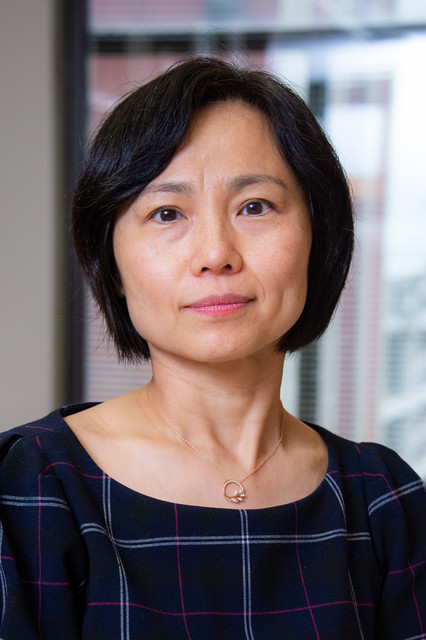Qin Wang, M.D., Ph.D.
Neuropharmacology
Augusta University
Recruited: 2022
Qin Wang works to untangle the chemical events in the brain that lead to Alzheimer’s Disease and other neurological ailments.
Her area of expertise is neuropharmacology, which involves how drugs affect the central nervous system; and much of her research centers on brain receptors, which serve as the port to which certain chemicals (neurotransmitters) dock. Wang’s ultimate aim is to deepen understanding of what happens in this landscape so that more drugs can be created to treat Alzheimer’s, epilepsy, depression and other diseases and disorders.
Wang’s work in Alzheimer’s is especially significant. Two proteins in the brain, beta-amyloid and tau, are behind the havoc that brings on Alzheimer’s. The prevailing hypothesis holds that beta-amyloid triggers tau, which toxifies neurons and ultimately kills cells; it’s a sequence that’s been likened to the firing of a gun. Why and how this sequence happens has been a mystery, and Wang is helping to solve it.
She and her colleagues had been studying the brain chemical norepinephrine and a receptor to which it docks, alpha2A adrenergic receptor. (Norepinephrine’s activation of this receptor factors into the body’s fight-or-flight response.) In 2020, they discovered that beta-amyloid too can dock on the alpha2A receptor and redirect this norepinephrine-receptor machinery to begin a chemical cascade that ultimately fires the tau bullet.
Importantly, norepinephrine adds to beta-amyloid’s hijacking of the receptor, meaning that only a small amount of beta-amyloid is needed to play this catalytic role. The finding may explain why Alzheimer’s drugs that target beta-amyloid don’t cure the disease. While they reduce beta-amyloid, they don’t eliminate it, leaving the triggering mechanism intact.
Wang has built on this discovery by intensifying her study of the alpha2A receptor. She found three clues that merit much deeper investigation of this receptor as a potential target for treating Alzheimer’s more effectively.
First, she bred mice so that they don’t even have the receptor. In these mice, beta-amyloid plaque was significantly reduced, and the triggering of the tau protein occurred far less often.
Secondly, in mice that did have the receptor (and Alzheimer’s), Wang blocked the receptor with a drug, Idazoxan. Again, the cascading sequence that ultimately triggered tau was inhibited, and she found that cognition improved in these mice.
Finally, Wang validated her earlier research findings by studying people with and without Alzheimer’s who took the blood pressure medicine clonidine. The drug does activate the alpha2A receptor – and patients with Alzheimer’s who took the drug lost cognition to a greater degree during the time they took the drug (compared to the time they didn’t take it).
While the findings are promising, Wang acknowledges that the discovery of new therapeutics for Alzheimer’s and other diseases “will be a long journey.” At Augusta University, she is part of a larger initiative, “Inflammaging and Brain Aging,” designed to recruit top scientists and combine disciplines to speed progress on treating age-related diseases. To that effort, she is contributing both basic and translational research.
Research
Molecular and cellular mechanisms underlying Alzheimer’s disease (AD) pathogenesis
— noradrenergic dysfunction and adrenergic signaling in AD
— regulation of endosomal trafficking and its involvement in AD pathogenesis
— astrocyte reactivity in AD
— tumors and related therapies as risk factors for AD
Cognition and complex behaviors
— synaptic signaling in autism
— epigenetic regulation of anxiety
— a novel mouse model for ADHD.
Selective targeting of GPCRs
— neural-specific enhancement of adenosine receptor for neuroprotection
— signaling-specific targeting of adrenergic receptor for AD
Choosing Georgia
“When I came to visit Augusta University, I saw tremendous enthusiasm for this new program in Alzheimer’s Disease research. Everyone is really determined to push things forward, and the faculty are very collaborative and enthusiastic.”

